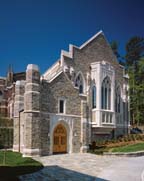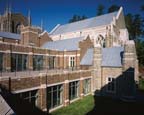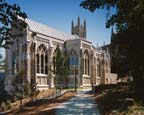

The Duke Chapel sits immediately in front of the Duke Divinity School and models a gothic cathedral, according to Project Architect Lee Becker of Hartman-Cox Architects. Additionally, the west campus features a series of gothic buildings designed by draftsman architect Julian Abele in the 1920s. “We wanted to complete the other end of the campus in character with the existing campus buildings that were built between the 1920s and the 1950s,†said Becker. “Our goal was to complete the cloister started by Duke, and to do it in the style and language of the existing campus. We also wanted to add more classroom administration and special program space, and to design a building that provides more interactive student gathering spaces outside of the classrooms.â€
The campus' traditional Duke Stone was selected for exterior portions of the building, as well as Rustic Buff Indiana limestone - from Bybee Stone Inc. of Bloomington, IN - which was used for trim, tracery and window surrounds. “The Rustic Buff is a really nice stone because it has some characteristics with fossils and inclusions, and existing buildings on campus used a fair amount of it,†said the architect. The entire west campus features Duke Stone, which Becker describes as fairly dark with a lot of iron and rust stains in it. “It is pretty interesting stuff,†he said, adding that the material is often compared to rough-cut Bluestone.
Duke University owns a quarry for the Duke Stone - which is located about 10 miles from the campus. The Duke Stone was taken to an off-campus site where it was fabricated to become 14,000 square feet of facade in seven primary colors and 17 shades of gray, beige, browns, rusts and blues.
The interior of the building's chapel features extensive stonework as well. “The convex curved panels in the lower wall of the chapel, the bosses at the base of the trusses, the sloped sills and trim are all limestone,†said Becker. “The floor and base in the chapel and the typical interior window sills outside of the chapel are clad in Pietra Serena sandstone.â€

Installation
Rugo Stone LLC of Lorton, VA, served as the installer for the project. According to Senior Project Manager Randy Boyer and President Brett S. Rugo, the stonework took 10 months to install with an average of 20 to 30 workers on the jobsite with a maximum of 55 workers at times.The stone was 10 inches solid and installed as rubble load-bearing wall construction, backed by a 2-inch ridge foam insulation board and drainage board system, according to Rugo and Boyer. Additionally, the stone system was structurally backed by poured-in-place concrete or Concrete Masonry Unit walls. Portland cement and lime mortar were used for setting the beds.
The “Stone Tab†rod and tie system for cavity reinforcing was supplied by Wire Bond, the limestone veneer wall ties were manufactured by Hohmann and Barnard. Special miscellaneous stainless anchorage was fabricated by Krando Metal Products of Broomall, PA.
The crew faced some difficulties involving the special rigging required for the installation of the fragile gothic carved limestone shapes. Also, the jobsite had various obstacles such as limited access, the sloping grades and the complex geometry of the building perimeters. The most time-consuming learning curve was the training of the masons to learn the proper field cutting of the Duke Stone, according to Rugo Stone. Over 14,500 square feet of the rubble walls were hand cut on site to match the original Cathedral stonework. The crew was also challenged to use the proper mix of 15 different tones of the Duke Stone to achieve the final color blending. In addition, the pointing of the mortar joints was one not usually seen as it is projecting 1-inch-wide joint in appearance.
“The school has said it is the finest work done on campus since the completion of the 1925 Cathedral,†said Rugo. “This job is 'super' high-quality hand craft, and it has been recognized by the University and architect as such. We are most proud of this effort.†Boyer added that the limestone fabrication by Bybee Stone Inc. was of excellent quality and above industry standards.
Construction, which lasted for two years, was completed in the spring of 2003.
“The reaction has been very positive,†said Becker. “People just love it. They walk by and you hear them make comments as to whether or not the building has always been there. Rugo and his guys did a fantastic job. We couldn't have had a better stone setter.â€

Credit Box
Duke Divinity SchoolDuke University
Durham, NC
Architect: Hartman-Cox Architects, Washington, DC
General Contractor: Skanska USA
Stone Suppliers: Duke University (Duke Stone); ProStone SRL, The Netherlands (sandstone); Bybee Stone Inc., Bloomington, IN (limestone)
Stone Fabricator: Bybee Stone Inc., Bloomington, IN (limestone)
Stone Installer: Rugo Stone LLC, Lorton, VA
Installation Products: Wire Bond (Stone Tab); Hohmann and Barnard (limestone veneer wall ties); Krando Metal Products, Broomall, PA (stainless anchorage)